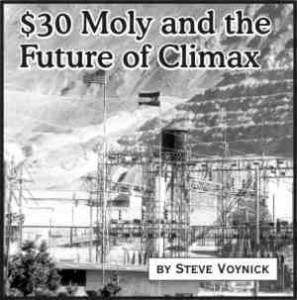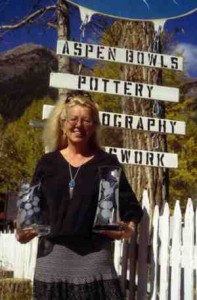Column by George Sibley
Water – July 2005 – Colorado Central Magazine
WATER ON THE BRAIN these days – I’m trying to organize Western State College’s annual Water Workshop. It’s the 30th conference, so we’re trying to take a larger look at the whole 30-year period – mostly because, water-wise, it has been a really interesting period.
When Dick Bratton, a Gunnison water attorney (and Salida native), and Western historian Duane Vandenbusche held the first Water Workshop in 1976, a lot of things had not happened.
We hadn’t stopped building big water projects, like the Central Arizona Project, under construction till the 1990s. And the “Carter Hit List” of 1977 that wiped out a lot of Wayne Aspinall’s proposed Colorado water projects had not happened.
The big environmental laws of the late 60s and early 70s – the Endangered Species Act, the National Environmental Policy Act, the Clean Water Act, Colorado’s Instream Flow Act, et cetera – were all in place, but their enforcement was still being worked out in tentative and fumbling ways. Most of the Colorado water establishment was still in denial about how important the emerging environmental awareness would be, but over the years between the Hit List of 1977 and the federal veto of Denver’s Two Forks Project in 1990, everyone learned.
The dry winter of 1976-77 had not given the ski industry the wake-up call that sent them all to snow-making, creating a significant new water demand at a very vulnerable time for streams. Recreational uses of any sort were still barely in the fold as “beneficial uses”; the idea of “in-stream recreational water rights” for whitewater parks would have set the water buffaloes into hysterical laughter.
Hardly anyone had even heard of “global warming,” and the nation was still mostly in denial about the meaning of the passing of the oil peak in the United States and the formation of OPEC. But Colorado began to be talked about that year as part of a “national sacrifice area” for massive energy production. Oil shale was being discussed.
The population of Colorado was less than 60 percent what it is today.
One could go on, but you get the idea. The biggest change, though, is something that has been kind of budding quietly for a while – probably since the 1990 Two Forks veto – but which seems to have flowered suddenly just this year, and that’s the outbreak of a spirit of negotiation and collaboration on water issues around the state. There are still buffalo who believe that “whiskey’s for drinkin’ and water’s for fightin’,” who are sure that the West Slope can’t trust the Front Range, the farmer can’t trust the city, and so forth. But all kinds of processes for discussion and negotiation of chronic, festering issues are suddenly being set up.
Most prominent of these is the new state law passed this winter that sets up permanent “roundtables” in nine Colorado water divisions. The roundtables are designed to bring together all of the division’s stakeholders to try to talk intrabasin issues through to resolution rather than heading them to court.
IT ALSO SETS UP an “interbasin compact committee,” with representatives from all of the roundtables and a few state appointees, to be the first line of approach in addressing interbasin issues, such as interbasin water transfers – and they’re not just “talking” but actually drafting resolutions in the form of “interbasin compacts,” like the seven states of the Colorado River Basin did more than 80 years ago.
Russ George, Director of Colorado’s Department of Natural Resources, was the guiding force behind this legislation, with two West Slope legislators, Representative Josh Penry of Grand Junction and Senator Jim Isgar of the southwest corner, carrying the bill.
No one really believes that this is going to eliminate the expensive water-court adventures that have been the way of doing things in the past, but it is a step toward cooperating more to negotiate problems. In conjunction with the State Water Supply Initiative, the new law may facilitate things like water availability, which entities have spent several million dollars in court to learn the hard way.
That this process now exists in the letter of the law means little, however, if the spirit of negotiation isn’t out there in the basins. But a group of Front Range utilities, led by Denver Water, have already begun a negotiation process with water entities up in the headwaters of the Colorado River on the West Slope to try to work out ways for the Front Range users to export water to which they have a legal title, but without seriously stressing the growing communities in the high valleys.
ALL OF THE INVOLVED parties are being very close-mouthed about what is actually happening in this process – meaning, mercifully, that no one is throwing around “not one drop” soundbites for the media. But according to Chips Barry, Manager of Denver Water, it is not just another “discussion” process: “The new element is that we’re talking about putting together the equivalent of an intrastate compact to regulate water uses within the state, much as the Colorado River Compact regulates uses between the states.” Sound familiar? But this started even before the governor signed the Penry-Isgar bill into law.
Meanwhile, a real test of the process may be emerging between the South Platte/Metropolitan, Arkansas and Gunnison Basins. State Senator Jim Dyer has resuscitated the Union Park Project, a high-altitude pumped-storage project just below the Continental Divide in the Upper Gunnison Basin. The project was intended to collect dribs and drabs of water from the Upper Gunnison area in wet years via a Rube Goldberg set of canals and pipes, for distribution to the Gunnison, Arkansas and South Platte/Metropolitan Basins in drier years.
Twice the Division Four water court judge has ruled that there is not enough unappropriated water in the upper reaches of the Gunnison River tributaries to supply the project, as originally conceived; both decisions were appealed by project backers to the Colorado Supreme Court. The first time, the question was remanded back to box one because of some questions allegedly not fully answered. The second time, the Supremes upheld the water court’s decision of insufficient water, but opined that, while the water was definitely not available from high in the Upper Gunnison valleys, there might be a “marketable pool” of unappropriated water in Blue Mesa Reservoir, maybe around 240,000 acre-feet, from agricultural and municipal runback. Close a door, open a window – wide enough to drive a D-9 through.
So, based on that, the new Union Park Project proposal is renamed the “Union Park-Aspinall Pool Project” – with “Emergency” tacked on in front to convey a sense of urgency. It proposes to move water (either physically or, preferably, on paper) to Union Park from Blue Mesa Reservoir rather than from the old system of ditches and pipes all over the valley.
It also capitalizes on the fact that the people of “not one drop” fame in the Upper Gunnison are trying to figure out how to build some high-altitude storage, with no money, to perfect some conditional rights they are about to lose. So trying to negotiate a new Union Park project through a Gunnison Basin Roundtable may be different this time around, since the Front Range people have the money to exchange for a portion of the water.
Meanwhile, however – problems are brewing with the grand-daddy and model of the water compacts, the Colorado River Compact. The seven Colorado River Basin states are trying to figure out how a drought plan can be pulled out of or fit into that Compact, but are getting pretty much nowhere. More about that down the road in a few months.
SUFFICE IT TO SAY FOR NOW – this emerging move away from contention toward negotiation is probably a positive way of sharing access to an essential resource that is in steady or diminishing supply. But even the most creative processes for sharing water among once-competing but now-collaborating users will not create any new water, and in the end there still may not be enough to do everything everyone wants to do.
Anyone interested in the Water Workshop’s effort to figure out what’s going on water-wise in the Southwest could check out the program on the web at www.western.edu/water. Among other attractions, we’ll hear from Governor Dick Lamm (1975-1987) on “The Angry West Revisited.”
George Sibley teaches, writes, and organizes in Gunnison.


